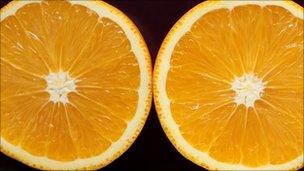'Microwave waste' to get biofuel
- Published

Only half an orange is used to make juice - the rest can be microwaved
Microwaving waste food products could be used to produce important chemicals and biofuels, new technology has shown.
The methods would potentially allow food waste to be processed at home and on an industrial scale.
The technology could provide a renewable source of carbon, as well as addressing the growing problem of global waste.
Professor James Clark of the University of York unveiled these plans at the British Science Festival in Bradford.
Using highly focused microwaves, the scientists believe they can input any organic waste, and extract useful chemical compounds that can be harnessed in materials and biofuel applications.
An international group of scientists have been working together to develop this technology, and they plan to build a demonstration facility in York later this year.
Future is orange
Waste is an unavoidable product of the increasingly complex processes of global food supply, with unused organic residues being produced in vast quantities at the farm, in the factory, and by the consumers themselves.
For example, in the production of cassava in Africa, 228 million tonnes of unused starch are produced each year, and the coffee grounds produced in Europe account for three million tonnes of waste a year. Much of the UK's waste comes from agricultural residues - the unused leaves and stalks and husks of cereals and farm crops.
In the commercial production of orange juice in Brazil, only half of the fruit is used, leaving the rest as waste. This orange peel makes up eight million tonnes a year of waste.
The project OPEC, or the Orange Peel Exploitation Company, plans to ultimately bring the new technology developed at the University of York to Brazil, where fuels and chemicals can be derived from this orange peel waste.
Professor Clark explained: "You dice the peel, put it into a microwave field, focus that microwave field as you would do with a domestic microwave, but at a much higher power. The microwaves activate the cellulose, triggering the release of a lot of chemicals."
One of these chemicals, called limonene, can be used directly in fragrances or contributing to making other highly-desired chemicals.
These orange peel-derived chemicals could ultimately be used to make many of the materials and chemicals that we currently rely on oil for.
Flexibility
Although the technology is still in testing, Professor Clark is optimistic about its potential to be used on all kinds of waste and on a range of scales.
The microwave technology would be able to process anything with cellulose in it, and works particularly well with paper and card.
They say it should be possible to put a range of waste types together into the machine and still extract useful substances.
The demonstration facility will be built later in the year to test this concept, and they expect to be processing 10kg of waste per hour.
If and when the technology becomes commercially available, the developers estimate that a machine costing around £1 million would be able to process around six tonnes of food waste per hour.
There is a limit to the maximum size of facility that can be built, because of the energy needed to make the microwaves, but OPEC hope the microwave machines may eventually be very flexible in size - usable in domestic to large scale industrial scenarios - and also transportable.
It is unclear whether this can become a carbon neutral process, but ultimately, all food waste produced at the farm, industrial, and domestic scales could be reused and recycled into clean renewable sources of carbon and chemicals.
- Published14 September 2011
- Published11 September 2011
- Published1 September 2011